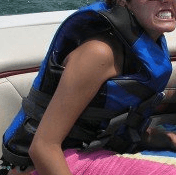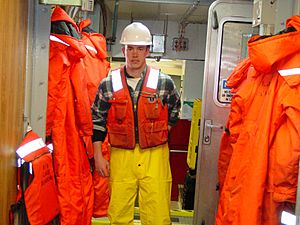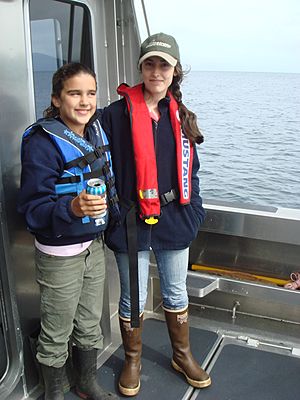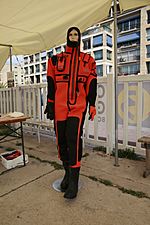Life vest facts for kids
A life vest is a special piece of clothing that helps people float in water. It's also called a lifejacket or a personal flotation device (PFD). Life vests are designed to keep your head above the water so you can breathe easily. There are different kinds of life vests, and they offer different amounts of floatation. Some can fill with air by themselves, while others need you to blow air into them.
Contents
Types of Life Vests
Buoyancy Aids (Foam Vests)
The simplest type of life vest is called a buoyancy aid. These vests are made of foam covered with nylon. They are often used for water sports like kayaking, canoeing, and dinghy sailing.
Buoyancy aids let you move freely while still helping you float. They are easy to take care of and are not very expensive to make. This makes them a very common type of PFD.
Some buoyancy aids are made just for kids and teens. These often have straps that go between your legs. These straps stop the vest from riding up when you are in the water. They also help keep you from slipping out of the vest. Many vests for all ages have these adjustable straps.
Kids' vests might also have a headrest flap. This flap helps support your head and keeps it out of the water. There's often a handle on the headrest too. This handle can be used to help lift someone out of the water.
Buoyancy aids are rated by how much they help you float. This is measured in Newtons (N). For example, a vest suitable for adults in open water needs to be at least 150 Newtons.
Inflatable Life Jackets
Life jackets for big ships or planes are often inflatable. They have one or two air chambers made of strong, coated nylon. Having two air chambers means if one gets a hole, the other can still work. Life jackets used on ships can also be made of foam.
Life jackets on aircraft are always inflatable. This is because if a plane lands in water, you might need to swim down to get out. An already inflated or foam vest would make it hard to swim down. Once you are on the surface, you can inflate the vest. You can do this by blowing into a tube or by pulling a cord that releases gas. Most passenger life jackets also have a plastic whistle to call for help. They also have a light that turns on when it touches water.
Good quality life jackets offer more floatation than simple buoyancy aids. They are designed to turn most people who are floating face down (like if they are unconscious) onto their back. This helps keep their face out of the water.
Today, these inflatable vests are popular for fun activities too. Many people use them for boating, fishing, sailing, and kayaking. They are often more comfortable and less bulky than older foam vests.
The air chambers are usually around your chest, shoulders, and the back of your head. They can be inflated in a few ways:
- By pulling a cord that releases carbon dioxide gas from a small cartridge.
- By blowing into a tube with a special valve.
- Some can even inflate automatically when they touch water.
The newest automatic vests inflate when water pressure activates them. This happens when you go under the water. All automatic life jackets can also be inflated manually if needed.
However, there's a small chance that water-activated vests might not inflate if you fall into water wearing waterproof clothes. The clothes might keep you floating on the surface, so the vest doesn't go deep enough to activate. Also, in some rare cases, these automatic vests could trap someone underwater if they capsize in a small boat.
A safer option is a vest that uses a small pill to inflate. This pill dissolves when it touches water. This type of vest is called an 'automatic' life jacket. It works even in shallow water where water pressure activators might not. Older models could sometimes inflate in heavy rain, but modern ones are much better. It's still a good idea to carry spare inflation kits just in case.
For people who might be in the open ocean for a long time, like on long sea trips or in the military, life jackets are often part of a special vest. This vest has pockets for survival gear. This can include a two-way radio, an emergency beacon, a signal mirror, flares, a strobe light, first-aid supplies, and even a knife.
Some life jackets also have leg straps to keep them in place. They might also have clear plastic shields that cover your face. These shields protect your face from waves and stop water from getting into your nose or mouth.
Survival Suits
Some life vests are part of a full survival suit. These suits are designed for long periods in cold water. They not only help you float but also keep you warm. While wetsuits or drysuits offer some floatation, they are not usually considered official life-saving devices.
If someone is unable to move in the water, they could still float face-down in a wetsuit or drysuit. This is because these suits are not made to turn a person onto their back like a life jacket does.
The Mark 10 Submarine Escape Immersion Equipment (SEIE) suit is an example of a survival suit. It helps submariners escape from very deep underwater. It's a full-body suit that also keeps the person warm once they reach the surface.
Buoyancy Compensators
Scuba divers wear a buoyancy compensator. This device has an inflatable air chamber. Divers can add or remove air from it to control if they float up, sink down, or stay at a certain depth. It also provides extra floatation in an emergency to bring them to the surface.
Specialized Life Vests
There are also special life jackets for different activities. For example, some are shorter for kayaking to allow more movement. Others are extra buoyant for river guides and whitewater professionals. Some PFDs even have harnesses for rescue work or loops to attach rescue gear.
Life Vests for Pets
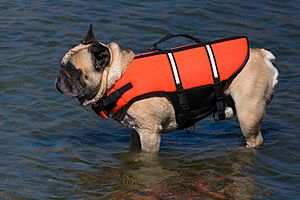
Life vests have also been made for dogs and other pets. Even though the United States Coast Guard doesn't officially approve pet PFDs, many companies make them. Dogs and cats can drown if they don't know how to swim, get too tired, or have a medical problem.
Most pet life jackets have foam that wraps around the animal's body and neck. They help a pet float, but might not always support their head enough, especially for heavier dogs. However, they often have a handle. This handle can be very helpful for lifting your pet back into a boat.
While most pet life jackets are simple foam vests, there are also automatic inflatable ones. These are usually more expensive. But like human automatic PFDs, they are less bulky when not inflated. When inflated, they can offer more floatation than foam vests. Automatic pet life jackets are popular for breeds like bulldogs and for water therapy where extra head support is needed.
Images for kids
See also
 In Spanish: Chaleco salvavidas para niños
In Spanish: Chaleco salvavidas para niños



